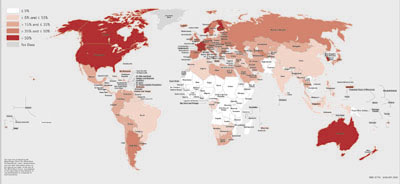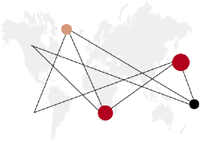|
"Human history becomes more and more a race
between education and catastrophe."
H.G. Wells. The Outline of History
The Task Force
The Task Force on Higher Education and Society was convened by
the World Bank and UNESCO. It brought together experts from 13 countries
to explore the future of higher education in the developing world.
Based on research and intensive discussion and hearings conducted
over a two-year period, the Task Force has concluded that without
more and better higher education, developing countries will find
it increasingly difficult to benefit from the global knowledge-based
economy.
The Task Force has attempted to clarify the arguments for higher
education development, especially from the standpoint of public
policy-makers and the international community. It has also diagnosed
specific problems that are common across the developing world –
home to over 80 per cent of the world’s population – and
suggested potential solutions.
“Peril and Promise: Higher Education in Developing Countries”
is split into 6 chapters, covering:
- higher education’s long-standing problems and the new
realities it faces.· the nature of the public interest
in higher education.
- how focusing on higher education as a system will yield the
benefits of planned diversification.
- the need to improve standards of governance.
- the particularly acute requirement for better science and technology
education.
- a call to develop imaginative general education curricula for
certain students.
Peril and Promise
The world economy is changing as knowledge supplants physical capital
as the source of present (and future) wealth. Technology is driving
much of this process, with information technology, biotechnology,
and other innovations leading to remarkable changes in the way we
live and work.
As knowledge becomes more important, so does higher education.
Countries need to educate more of their young people to a higher
standard – a degree is now a basic qualification for many skilled
jobs. The quality of knowledge generated within higher education
institutions, and its accessibility to the wider economy, is becoming
increasingly critical to national competitiveness.
This poses a serious challenge to the developing world. Since the
1980s, many national governments and international donors have assigned
higher education a relatively low priority. Narrow – and, in
our view, misleading – economic analysis has contributed to
the view that public investment in universities and colleges brings
meager returns compared to investment in primary and secondary schools,
and that higher education magnifies income inequality.
As a result, higher education systems in developing countries are
under great strain. They are chronically under-funded, but face
escalating demand – around half of today’s higher education
students live in the developing world. Faculty are often under-qualified,
lack motivation, and are poorly rewarded. Students are poorly taught
and curricula under-developed. Developed countries, meanwhile, are
constantly raising the stakes. Quite simply, many developing countries
will need to work much harder just to maintain their position, let
alone to catch up. There are notable exceptions, but currently,
across most of the developing world, the potential of higher education
to promote development is being realized only marginally.
Wider Focus
The Task Force is united in the belief that urgent action to expand
the quantity and improve the quality of higher education in developing
countries should be a top development priority. Developing countries
need higher education to:
- provide increasing numbers of students, especially those from
disadvantaged backgrounds, with specialized skills – specialists
are increasingly in demand in all sectors of the world economy.
- produce a body of students with a general education that encourages
flexibility and innovation – allowing the continual renewal
of economic and social structures relevant to a fast-changing
world.
- teach students not just what is known now, but also how to
keep their knowledge up-to-date, so that they are able to refresh
their skills as the economic environment changes.
- increase the amount and quality of in-country research –
allowing the developing world to select, absorb, and create new
knowledge more efficiently and rapidly than is currently the case.
The Task Force recognizes that there are many difficulties in achieving
these aims, including the plethora of competing demands for public
money. Action, therefore, will need creativity and persistence.
A new vision of what higher education can achieve is required, combined
with better planning and higher standards of management. The strengths
of all players – public and private – must be used, with
the international community at last emerging to provide strong and
coordinated support and leadership in this critical area.
System Focus
The Task Force recommends that each developing country make it
a national priority to debate and determine what it can realistically
expect its higher education system to deliver. The debate must be
informed by historical and comparative knowledge about the contribution
of higher education to social, economic, and political development
– but also should take clear account of the challenges the
future will bring. It should establish for each higher education
system clear goals that policy-makers can use to view the higher
education system as a whole, determining what each part can contribute
to the public good.
This kind of holistic analysis of higher education systems has
rarely been attempted. It does not mean reverting to centrally planned
systems – far from it. Instead, it offers the ability to balance
strategic direction with the diversity now found in higher education
systems across the developing world. This diversification –
a reaction to increased demand – has brought new providers
(especially from the private sector) into the system and encouraged
new types of institutions to emerge. It promises increased competition
and, ultimately, improved quality.
Unfortunately, this promise will not be delivered if diversification
continues to be chaotic and unplanned. Players – new and old
– will thrive only in higher education systems that develop
core qualities. These include:
- sufficient autonomy, with governments providing clear supervision,
but not day-to-day management.
- explicit stratification, allowing institutions to play to their
strengths and serve different needs, while competing for funding,
faculty, and students.
- cooperation as well as competition, with human and physical
capital, as well as knowledge and ideas, profitably shared within
the system, creating, for example, a ‘learning commons’
where facilities – computers, libraries, laboratories –
are open to any and all students.
- increased openness, encouraging higher education institutions
to develop knowledge- (and revenue-) sharing links with business
and to deepen the dialogue with society that will lead to stronger
democracy and more resilient nation states.
On its own, the market will certainly not devise this kind of system.
Markets require profit and this can crowd-out important educational
duties and opportunities. Basic sciences and the humanities, for
example, are essential for national development. They are likely
to be under-provided, unless actively encouraged by leaders in education
who have the resources to realize their vision.
Governments need to develop a new role as supervisors of higher
education, rather than directors. They should concentrate on establishing
the parameters within which success can be achieved, while allowing
specific solutions to emerge from the creativity of higher education
professionals.
Practical Solutions
The Task Force has identified a number of areas where immediate,
practical action is needed. These include:
· funding – the Task Force suggests a mixed funding
model to maximize the financial input of the private sector, philanthropic
individuals and institutions, and students. It also calls for
more consistent and productive public funding mechanisms.;
· resources – the Task Force makes practical suggestions
for the more effective use of physical and human capital, including
an urgent plea for access to the new technologies needed to connect
developing countries to the global intellectual mainstream.
· governance (acknowledged by many as the central problem
facing higher education in developing countries) – the Task
Force proposes a set of principles of good governance and discusses
tools that promote their implementation: better management will
lead to the more effective deployment of limited resources.
· curriculum development, especially in two contrasting
areas, science and technology, and general education; the Task
Force believes that, in the knowledge economy, highly trained
specialists and broadly educated generalists will be at a premium,
and both will need to be educated more flexibly so that they continue
to learn as their environment develops.
Figure 1

Tertiary Enrollment Ratios, 1995
(Click map to enlarge)
The Way Forward
“Peril and Promise: Higher Education in Developing Countries”
does not offer a universal blueprint for reforming higher education
systems, but it does provide a starting point for action. The Task
Force wants more than anything to catalyze dialogue in countries
around the world. While the benefits of higher education are continuing
to rise, the costs of being left behind are also growing. Higher
education is no longer a luxury; it is essential to future national
social and economic development.
|

